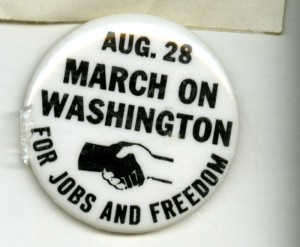 On the fiftieth anniversary of Martin Luther King, Jr.’s ‘I Have a Dream’ speech in Washington, D.C. on August 28, 1963, and as many in our nation pause today at 3:00 p.m. (Eastern Time) to commemorate this seminal event, it’s good to be reminded also of the many resources available at Williams College related to Dr. King, to the history of the Civil Rights movement in America, and to African-American history and culture in general.
On the fiftieth anniversary of Martin Luther King, Jr.’s ‘I Have a Dream’ speech in Washington, D.C. on August 28, 1963, and as many in our nation pause today at 3:00 p.m. (Eastern Time) to commemorate this seminal event, it’s good to be reminded also of the many resources available at Williams College related to Dr. King, to the history of the Civil Rights movement in America, and to African-American history and culture in general.
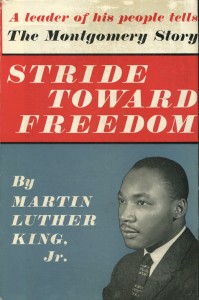 The Chapin Library contains several books by Dr. King, including Stride toward Freedom and Why We Can’t Wait, both signed by the author, the latter also with an inscription by Coretta Scott King, and a special printing of Dr. King’s speech on accepting the 1964 Nobel Peace Prize. Also here is a dramatic 1965 telegram from Dr. King to Congressman Seymour Halpern (one of the co-sponsors of the Voting Rights Act of 1964), in connection with a dispute over Negro disenfranchisement in Mississippi.
The Chapin Library contains several books by Dr. King, including Stride toward Freedom and Why We Can’t Wait, both signed by the author, the latter also with an inscription by Coretta Scott King, and a special printing of Dr. King’s speech on accepting the 1964 Nobel Peace Prize. Also here is a dramatic 1965 telegram from Dr. King to Congressman Seymour Halpern (one of the co-sponsors of the Voting Rights Act of 1964), in connection with a dispute over Negro disenfranchisement in Mississippi.
Extensive holdings from earlier periods trace the arrival of African captives in the New World, the development of slavery in America, and the struggles of African-Americans to claim their civil rights following the Civil War. Among these are works by civil rights activist (and Great Barrington native) W.E.B. Du Bois, who died fifty years ago yesterday, on August 27, 1963. Such resources are available in both the Chapin Library and the Williams College Archives and Special Collections, located in the Southworth Schoolhouse.
In addition, as noted in an earlier post, a recent acquisition by the Chapin Library, the Heritage Collection of Black literature and music formed by Paul Breman, comprises some 4,000 books and recordings and an equal number of pieces of manuscript and ephemera. – WGH
Shown are a button from August 28, 1963, from the Williams College Archives’ image collection related to the march on Washington, and from the Chapin Library’s holdings, the dust-jacket of Stride toward Freedom: The Montgomery Story by Martin Luther King, Jr. (1958).
Discussion: Comments Off on Let Freedom Ring
Categories: Collections
Time: 12:19pm on the 28th of August, 2013
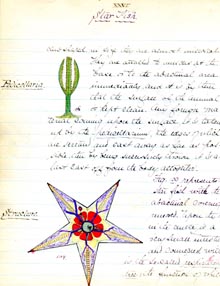
Maxcy’s description of a starfish (accession 2013.023)
Curious about what your biology class would have been studying in 1884? Come take a look at the Archives’ newest gift, Carroll Lewis Maxcy’s laboratory notebook. In addition to his beautifully penned notes, the volume is filled with brilliantly-colored illustrations of starfish, frogs, molds, and ferns.
Maxcy did not specialize in science after his graduation in 1887. Rather, he returned to Williams to teach English and Rhetoric for many years, also serving as dean and acting president.
The notebook is the gift of Jean Matthews Halverson, daughter of the late Prof. Samuel Matthews who taught biology at Williams from 1937 to 1970.
Discussion: Comments Off on 19th-century Biology notes just received in the College Archives
Categories: Collections
Time: 10:42am on the 5th of August, 2013
The annual public reading by actors from the Williamstown Theatre Festival of the Declaration of Independence of July 1776, the British reply to the Declaration of September 1776, King George III’s speech to Parliament of October 1776, and the Preamble to the U.S. Constitution will take place – rain or shine – on Thursday, July 4th, at 2:00 p.m. at the Williams College Museum of Art. Admission is free, and families are encouraged to attend. The documents will be read this year by Robert Sean Leonard (House) and Paxton Whitehead (The Importance of Being Earnest). Both actors will be featured in the upcoming WTF production of George Bernard Shaw’s Pygmalion, July 17–27.
The Chapin Library’s collection of original Founding Documents of the United States is on display at the Williams College Museum of Art until the completion of the Stetson-Sawyer project in 2014. On July 4th, the Museum galleries will be open from 1:00 to 4:00, with Library staff available to answer questions about the Founding Documents. – WGH
Discussion: Comments Off on Independence Day Readings
Categories: Collections and Events
Time: 9:40am on the 2nd of July, 2013
Please browse our recently digitized Shaker Collection Highlights. The collection includes resolutions adopted at the Shakers 1905 Peace Convention, a pamphlet on vegetarianism, songbooks, advertisements, and the United Society of Believers in Christ’s Second Appearance’s first theological treatise (1790).
Browse the digital collection here.
-JGD
Vegetarianism Among Shakers
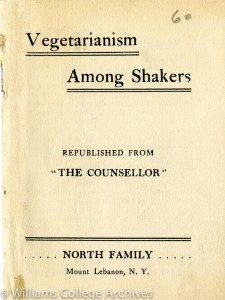
Shaker Cloak
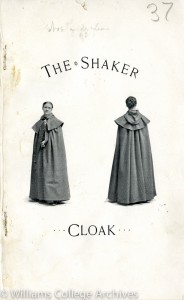
Shakers at Orchard Beach
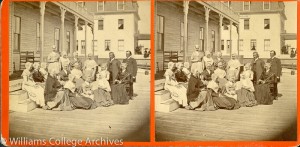
Discussion: Comments Off on Shaker Collection Highlights Digitized
Categories: Articles
Time: 10:09am on the 17th of June, 2013
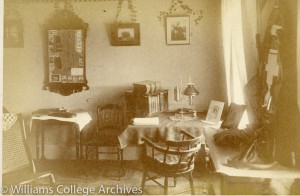
Archives and Special Collections were recently gifted two photographs (gift of Gordon and Karen Clark, class of 1951), circa 1885, detailing the interior of a Kappa Alpha fraternity house. Showing Herbert J. Brown’s (class of 1885) dormitory room, the decor includes a stand complete with sheet music, a desk overflowing with textbooks, handheld fans, an oil lamp, and several portrait photographs adorning the walls. – JGD
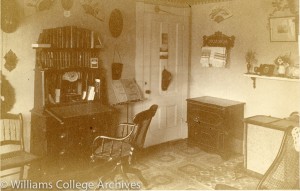
Discussion: Comments Off on Williams College Kappa Alpha Dormitory, circa 1885
Categories: Articles
Time: 9:14am on the 8th of May, 2013
Last week, the Chapin Library and Williams College Archives & Special Collections welcomed Visiting Assistant Professor Llerena Searle’s Anthropology class, “Financial Lives”, concerned with aspects of finance and investment.
The collections of the Chapin Library and College Archives hold many examples of ancient and modern coinage, bills, ledgers, and other financial accounts, as well as books and broadsides dealing with currency and financial issues. Students carefully examined materials ranging from a coin from the reign of Roman Emperor Tiberius to the 1747/8 account book of Fort Massachusetts, a United States 1785 ten-dollar gold coin, George Washington’s manuscript account of his (losing) investments in Revolutionary War loan certificates, American money of the colonial period, and currency issued by the Confederate States of America during the Civil War. – JGD/SKB/WGH
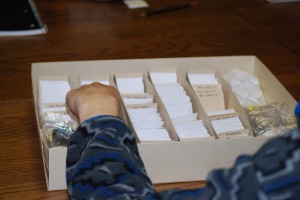
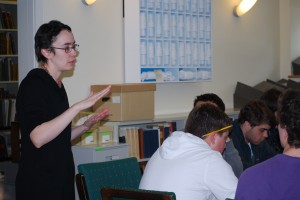
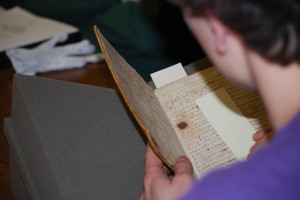
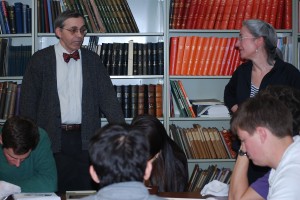
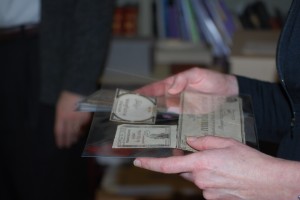
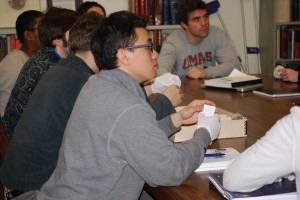
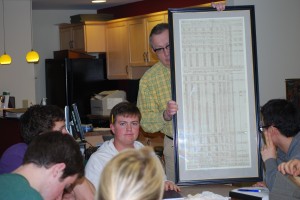
Discussion: Comments Off on Anthropology of Currency
Categories: Classes and Collections
Time: 8:50am on the 28th of February, 2013
“I just recall a man making the rounds of the fraternities and quickly drawing many of the members,” recollects Dick Debevoise, Class of 1946. We know no more than this about how and why George Pal came to Williams to draw student caricatures in 1946.
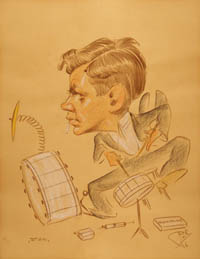 Happily two of Pal’s drawings survived and were gifted last year to the Williams College Archives. Mr. Debevoise’s portrait was received as one item within the larger donation of the Debevoise Family Papers. Several months later, the drawing of Stanton Tefft (left), Class of 1947, came as a single piece, the generous gift of his widow, Marie Elaine Tefft.
Happily two of Pal’s drawings survived and were gifted last year to the Williams College Archives. Mr. Debevoise’s portrait was received as one item within the larger donation of the Debevoise Family Papers. Several months later, the drawing of Stanton Tefft (left), Class of 1947, came as a single piece, the generous gift of his widow, Marie Elaine Tefft.
Pal’s caricatures are fascinating in the manner in which they capture aspects of the sitter. Mr. Tefft, for instance, was known as the drummer for the college’s V-12 (Navy College Training Program) Swing Band. The exuberance with which he is portrayed reflects the enthusiasm he brought later to his law career and his many varied life interests.
Pal, as it turns out, was not known for his caricatures (as artistic and entertaining as ours may be). He is, however, legendary for the science fiction films he directed and produced at Paramount. He won Academy Awards for special effects work on “The War of the Worlds” (1953) and “The Time Machine” (1960), among others. Before these live-action films—and at the time he was drawing the caricatures—he was a pioneer of stop-action animation. His Puppetoons—a term he coined from a combination of “puppet” and “cartoon”—used wooden puppets and stop-action photography to create a style of animation that Americans had never before seen.
The caricatures are only a small part of the visual holdings in the College Archives. Our collections include photographic prints, early photographic processes (daguerreotypes, ambrotypes and tintypes), lithographic and woodcut prints, drawings and paintings depicting college life and our region. You can find a small sampling of the Archives’ image collections by visiting the Williams Memory Project. – SKB
Shown is George Pal’s 1946 pastel and chalk caricature of Stanton Tefft, Class of 1947 (accession # 2012.112)
Discussion: Comments Off on Caricatures Donated to College Archives
Categories: Articles and New acquisitions
Time: 11:01am on the 20th of February, 2013
Selections from the Heritage Collection formed by Paul Breman (1931–2008) are on view on the first floor of Sawyer Library through February 3rd. Dutch-born and educated, Paul Breman was known among black poets as “that crazy white boy who takes us seriously”.
Breman’s collection encompasses in depth the poetry of black Africa and of the diaspora of black Africans into the Caribbean and the United States. It also includes a wide selection of plays, fiction, and other prose literature, and is further enriched with Breman’s substantial library of reference books and studies of black literature, music, and culture. Altogether, some 4,000 books, pamphlets, broadsides, and recordings, and another 4,000 pieces of manuscript and ephemera, comprise this latest major addition to the Chapin Library’s collections.
Three of the books on display are representative of Breman’s own works studying and promoting black literature. Another two volumes are examples of the amazing 400 anthologies of black-authored poetry Breman collected.
The Heritage Collection is also replete with more than 1,000 graphics by black artists that accompany the literary compositions. Nothing, though, breathes life into the collection better than do the readings by over a hundred poets for whom Breman found commercial recordings, private tapes, or conducted reading sessions himself.
Paul Breman’s distinguished collection came to the Chapin Library in 2012 through the generosity of his widow, Jill Norman, and the advice of her friend Darra Goldstein, Willcox B. and Harriet M. Adsit Professor of Russian at Williams College. News stories about this donation may be found on the Williams website, in the Williams Magazine, and in the Williams Record, while the collection itself may be consulted by appointment in the Chapin Library at the Southworth Schoolhouse. – RLV
Addendum, February 4th: The display from the Breman Collection in Sawyer Library has been extended during Black History Month.
Discussion: Comments Off on Breman Collection on View
Categories: Collections , Exhibitions and New acquisitions
Time: 3:49pm on the 25th of January, 2013
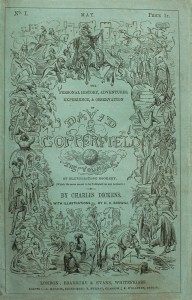 Before this year comes to a close, we would like to take note of three important bicentenaries in 2012, each of which could be celebrated with items in the Chapin Library.
Before this year comes to a close, we would like to take note of three important bicentenaries in 2012, each of which could be celebrated with items in the Chapin Library.
The first is the two hundredth anniversary of the birth of Charles Dickens. Born in Portsmouth, England, on 7 February 1812, Dickens became a tremendously successful writer, popular then and now on both sides of the Atlantic. The Chapin Library has an extensive collection of Dickens’ works in first editions, including some of his novels as issued in monthly parts – a device which put the works within reach of less pecunious readers while making money for the author through advertising. A year ago in this feature, we marked the Christmas season by illustrating a page from Dickens’ A Christmas Carol (1843).
 The second bicentenary is that of Edward Lear, born in London on 12 May 1812. Lear is probably best known today as a nonsense poet, inventor of limericks and creator of the Owl and the Pussycat who “went to sea / In a beautiful pea-green boat”. But he was also a serious artist, painter of vivid landscapes from his visits to Greece and Egypt, India and Ceylon (Sri Lanka). And he contributed illustrations of birds to works by the noted ornithologist John Gould. His picture of a Great Horned Owl, or Eagle Owl, for Gould’s Birds of Europe (1832), seems to have a cheeky expression.
The second bicentenary is that of Edward Lear, born in London on 12 May 1812. Lear is probably best known today as a nonsense poet, inventor of limericks and creator of the Owl and the Pussycat who “went to sea / In a beautiful pea-green boat”. But he was also a serious artist, painter of vivid landscapes from his visits to Greece and Egypt, India and Ceylon (Sri Lanka). And he contributed illustrations of birds to works by the noted ornithologist John Gould. His picture of a Great Horned Owl, or Eagle Owl, for Gould’s Birds of Europe (1832), seems to have a cheeky expression.
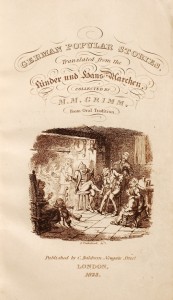 Finally, 2012 is the two hundredth anniversary of the first publication of Kinder- und Hausmärchen (Children’s and Household Tales) by the brothers Grimm, Jacob and Wilhelm. Grimm’s Fairy Tales have long been an integral part of Western culture: a new edition of selections from the Grimms’ tales appeared this year, as retold by Philip Pullman. The Chapin Library has a copy of the first selection translated into English, published in 1823–26 and illustrated by George Cruikshank.
Finally, 2012 is the two hundredth anniversary of the first publication of Kinder- und Hausmärchen (Children’s and Household Tales) by the brothers Grimm, Jacob and Wilhelm. Grimm’s Fairy Tales have long been an integral part of Western culture: a new edition of selections from the Grimms’ tales appeared this year, as retold by Philip Pullman. The Chapin Library has a copy of the first selection translated into English, published in 1823–26 and illustrated by George Cruikshank.
The staffs of the Chapin Library and College Archives wish all of our readers happy holidays and a splendid New Year. – WGH
Shown, top to bottom, is the cover of the first part of David Copperfield by Charles Dickens (1849), the Eagle Owl by Edward Lear for Gould’s Birds of Europe, and the title-page, with illustration by Cruikshank, for the Grimms’ German Popular Stories.
Discussion: Comments Off on Bicentenaries Galore
Categories: Collections
Time: 3:53pm on the 21st of December, 2012
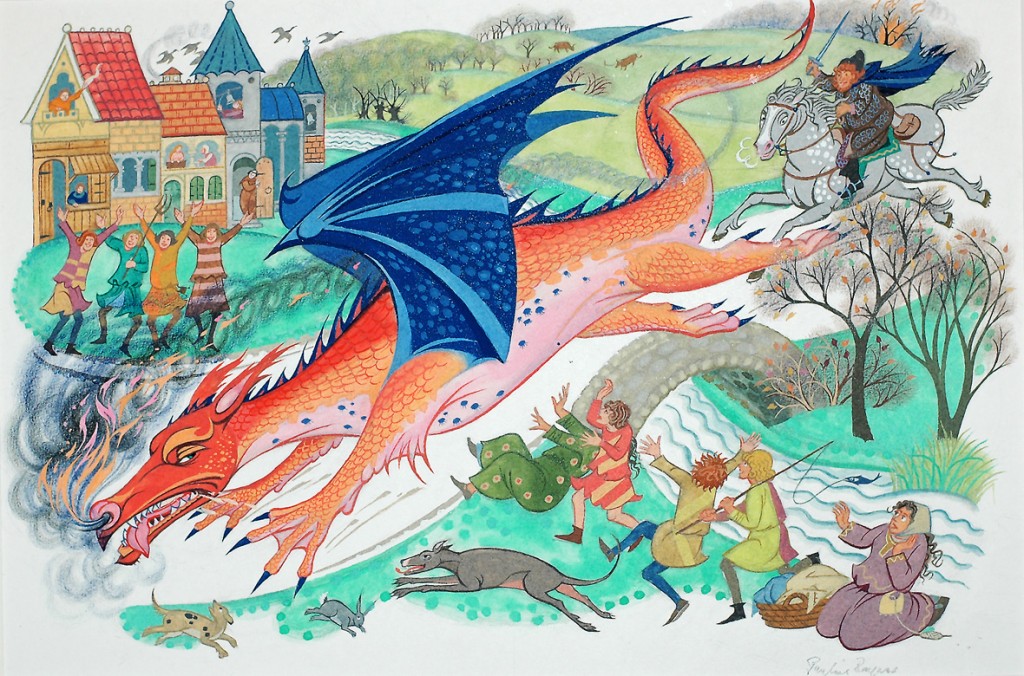
Throughout her career, Pauline Baynes (1922–2008) was known for pictures of fantastic beasts, from dragons and mermaids to ghouls and goblins. For the Chapin Library’s contribution to Halloween Screamings, we present three original gouache paintings by Baynes for an unpublished series, Mythical Creatures: St. George and the dragon, Lewis Carroll’s Jabberwock, and the giant spider Shelob from Tolkien’s Lord of the Rings. These may be seen in the flat exhibition case on the first floor of Sawyer Library, near the Access Services desk and the new books display, from today through Sunday, November 4th.
Pauline Baynes, the original illustrator of the seven ‘Narnia’ books by C.S. Lewis and of writings by J.R.R. Tolkien, also produced thousands of images for books by other authors. Her archive of original art and her personal collection of books were received by Williams in 2009 and may be seen at the Chapin Library. – WGH
Shown is a fourth painting in the same series, of the dragon Chrysophylax from Tolkien’s story Farmer Giles of Ham. (Art copyright © the Williams College Oxford Programme; all rights reserved.)
Discussion: Comments Off on Mythical Creatures
Categories: Collections and Exhibitions
Time: 4:10pm on the 22nd of October, 2012
 On the fiftieth anniversary of Martin Luther King, Jr.’s ‘I Have a Dream’ speech in Washington, D.C. on August 28, 1963, and as many in our nation pause today at 3:00 p.m. (Eastern Time) to commemorate this seminal event, it’s good to be reminded also of the many resources available at Williams College related to Dr. King, to the history of the Civil Rights movement in America, and to African-American history and culture in general.
On the fiftieth anniversary of Martin Luther King, Jr.’s ‘I Have a Dream’ speech in Washington, D.C. on August 28, 1963, and as many in our nation pause today at 3:00 p.m. (Eastern Time) to commemorate this seminal event, it’s good to be reminded also of the many resources available at Williams College related to Dr. King, to the history of the Civil Rights movement in America, and to African-American history and culture in general. The Chapin Library contains several books by Dr. King, including Stride toward Freedom and Why We Can’t Wait, both signed by the author, the latter also with an inscription by Coretta Scott King, and a special printing of Dr. King’s speech on accepting the 1964 Nobel Peace Prize. Also here is a dramatic 1965 telegram from Dr. King to Congressman Seymour Halpern (one of the co-sponsors of the Voting Rights Act of 1964), in connection with a dispute over Negro disenfranchisement in Mississippi.
The Chapin Library contains several books by Dr. King, including Stride toward Freedom and Why We Can’t Wait, both signed by the author, the latter also with an inscription by Coretta Scott King, and a special printing of Dr. King’s speech on accepting the 1964 Nobel Peace Prize. Also here is a dramatic 1965 telegram from Dr. King to Congressman Seymour Halpern (one of the co-sponsors of the Voting Rights Act of 1964), in connection with a dispute over Negro disenfranchisement in Mississippi.















